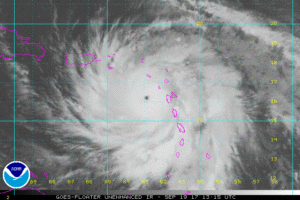
In their June 4 updated forecast, hurricane researchers at Colorado State University predicted a near-average Atlantic hurricane season in 2019 – a slight increase in severity from their initial forecast issued in early April. The report also calls for a 44 percent chance of a hurricane making landfall somewhere in the Caribbean.
The update calls for a slightly more severe season than its April forecast, which suggested a “slightly below average” season. The upgrade matches the forecast issued last week by the National Oceanic and Atmospheric Administration, which also called for a “near normal” season.
The CSU forecast anticipates that weak El Niño conditions are likely to persist through most of the hurricane season. El Niño tends to increase upper-level westerly winds across the Caribbean into the tropical Atlantic, tearing apart hurricanes as they try to form. That is likely to be offset, the forecasters says, by warmer ocean temperatures in the Northern Atlantic.
Tropical Atlantic sea surface temperatures have warmed up slightly faster than normal since early April and are now near normal. Warmer-than-normal sea surface temperatures in the tropical Atlantic are conducive for an active hurricane season, since they provide more fuel for tropical cyclone formation and intensification. They are also associated with a more unstable atmosphere as well as moister air, both of which enhance organized thunderstorm activity necessary for hurricane development.
13 more named storms this season
The CSU Tropical Meteorology Project team is predicting 13 additional named storms during the Atlantic hurricane season, which runs from June 1 to November 30. The Atlantic had one named storm – Andrea – in May, so the full seasonal forecast is for 14 named storms. Of these named storms, researchers expect six to become hurricanes and two to reach major hurricane strength, a 3, 4 or 5 on the Saffir/Simpson scale, with sustained winds of 111 miles per hour or greater.
The team bases its forecasts on a statistical model, as well as a new model that uses a combination of statistical information and forecasts from a dynamic model. Both of these models are built on about 40 years of historical data and evaluating conditions including: Atlantic sea surface temperatures, sea level pressures, vertical wind shear levels (the change in wind direction and speed with height in the atmosphere), El Niño (warming of waters in the central and eastern tropical Pacific), and other factors.
So far, the 2019 hurricane season is exhibiting characteristics similar to 1990, 1991, 2012, 2014 and 2018. “1991 and 2014 had below-average Atlantic hurricane activity, 1990 had near-average hurricane activity, and 2012 and 2018 had above-average Atlantic hurricane activity,” Phil Klotzbach, a research scientist in the Department of Atmospheric Science and lead author of the report, said.
The team predicts that 2019 hurricane activity will be about 95 percent of the average season. By comparison, 2018’s hurricane activity was about 125 percent of the average season. The 2018 season was most notable for Hurricanes Florence and Michael, which devastated the Carolinas and portions of the Florida Panhandle, respectively.
The CSU team will issue forecast updates on July 9 and August 5.
This is the 36th year that the CSU hurricane research team has issued its Atlantic basin seasonal hurricane forecast.
As always, the researchers caution coastal residents to take proper precautions.
“It takes only one storm near you to make this an active season,” Bell said.
Landfall probability included in report
The report also includes the probability of major hurricanes making landfall:
– 54 percent for the entire U.S. coastline (average for the last century is 52 percent)
– 32 percent for the U.S. East Coast including the Florida peninsula (average for the last century is 31 percent)
– 31 percent for the Gulf Coast from the Florida Panhandle westward to Brownsville (average for the last century is 30 percent)
– 44 percent for the Caribbean (average for the last century is 42 percent)
The forecast team also tracks the likelihood of tropical storm-force, hurricane-force and major hurricane-force winds occurring at specific locations along the coastal United States, the Caribbean and Central America through its Landfall Probability website.
The site provides information for all coastal states as well as 11 regions and 205 individual counties along the U.S. coastline from Brownsville, Texas, to Eastport, Maine. Landfall probabilities for regions and counties are adjusted based on the current climate and its projected effects on the upcoming hurricane season.





